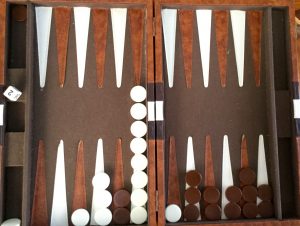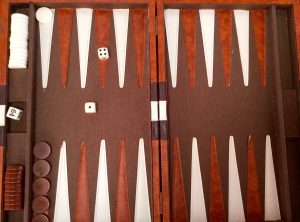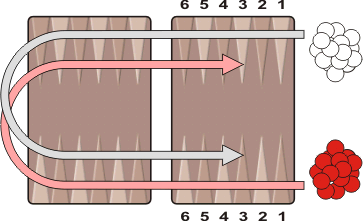Best 2-Person Game for Cruising Couples (no, not arm wrestling)
If you ever hear that Rand has fallen overboard, your first question should be “were you in the middle of an acey-deucey game?” Truth be told, sometimes I do wish Rand would take his incredible dice-rolling luck to Las Vegas rather than roll back-to-back acey-deucies and doubles as he seems to do much more than random statistics would allow. I never will throw him overboard and the great thing about Acey-Deucey is that…
It’s Never Over ‘Til It’s Over!
What makes Acey-Deucey the best game ever is that you can be miserably behind and still end up winning. The biggest reason for this is that, unlike regular backgammon where you get to take off any pieces with the number of your dice roll or lower, in acey-deucey, you only take off from the places of your roll.

almost trapped in my home board after Rand’s great opening rolls
Case in point – playing Rand this morning while we enjoyed our morning coffee. Right from the beginning, within a few rolls, Rand appeared to have crushed me, blocking me so I was getting stuck in my beginning board, his home board.
Strategically, my best chance was to block off as many of the higher numbers of his home board spots, forcing his pieces into the 1 & 2 spots, which is a tough position to take off and end the game from.
It was looking bleak for me. I’m the white checkers, barely out of my home board (lower left) while Rand has had so many doubles and acey-deucey rolls, he’s advanced all the way around the board to pressure me.

my winning roll with one checker left on the board
And then, I got a few lucky 6 rolls myself, allowing me to advance past his five blocked spaces. Turnabout. And I ended up winning.
We can play acey-deucey every day and no two games are ever the same, or ever lack for suspense and challenge. We highly recommend acey-deucey to all solid couples who can handle some competition.
In case you’ve never played acet-deucey before, here is how you do it.
Rules of the Game
Setup: Each player starts with fifteen checkers off the board. The players enter their checkers in the opponent’s home board, then bring them around the board as shown in the diagram below.

Object: The object of the game is to move all of your checkers around the board to your own home table and then bear them off. The first player to bear off all of his checkers wins the game.
To start: Each player rolls one die and the higher number goes first. That player then rolls both dice again to begin his first turn.
Entering checkers: You enter a checker by placing it on a point in the opponent’s home board corresponding to a number rolled. For example, if you roll 6-3, then you enter one checker on the opponent’s six-point and one checker on his three-point. Once you have entered one or more checkers, you may use subsequent rolls to move those checkers forward, to enter more checkers, or both.
Movement: The roll of the dice indicates how many points, or pips, the player is to move his checkers. The following rules apply:
- A checker may be moved only to an open point, one that is not occupied by two or more opposing checkers.
- The numbers on the two dice constitute separate moves. For example, if you roll 5 and 3, you may move one checker five spaces to an open point and another checker three spaces to an open point, or you may move the one checker a total of eight spaces to an open point, but only if the intermediate point (either three or five spaces from the starting point) is also open.
- Doubles are played twice. For example, a roll of 6-6 means you have four sixes to use.
- You must use both numbers of a roll if possible, or all four numbers in the case of doubles. If you can play one number but not both, you must play the higher one.
Acey-deucey: The roll of 1 and 2 (acey-deucey) is especially valuable. When you roll 1-2, this is what happens:
- First you play the 1 and 2 in the normal way.
- Then you name any roll of doubles you wish and play it accordingly.
- Then you roll again and play the roll as usual.
- If the number rolled is another 1-2, you keep going—naming and playing a double of your choice, and then rolling again.
Note, however, if you are unable to use any part of your roll, you forfeit the rest of your turn. For example, if you can move your 2 but cannot use the 1, you may not name a double and you may not roll again.
It is permissible to name a double even if only part of it can be used. For example, after moving 1 and 2, you can name 6-6 as your double even if only three of the 6s can be played. You would then lose the fourth 6, and you wouldn’t get to roll again.
Hitting: A checker sitting alone on a point is called a blot. If an opposing checker lands on a blot, the blot is hit and placed on the bar.
Entering from the bar: Any time you have one or more checkers on the bar, your first obligation is to reenter those checker(s) into the opponent’s home board. You reenter a checker by moving it to an open point corresponding to one of the numbers on the rolled dice. If you are able to enter some but not all of your checkers on the bar, you must enter as many as you can then give up the remainder of your turn.
Bearing Off: Once you have moved all fifteen of your checkers into your home board, you may begin bearing off. You bear off a checker by rolling a number that corresponds to the point on which it resides, then removing the checker from the board.
If there is no checker on the point indicated by the roll, you must make a legal move using a checker on a higher-numbered point. If there are no checkers on higher-numbered points, you must remove a checker from the highest point that has a checker.
Scoring: The loser pays one point for each of his checkers still on the board (or yet to be entered). Gammons and backgammons do not count extra.
The doubling cube is not used in acey-deucey.
Strategy: Because the roll of 1-2 is so powerful, luck plays a greater part in acey-deucey than in regular backgammon. You are never completely out of a game. On the other hand, since you start with fifteen men back, there is some added opportunity for skill in placing your checkers to block the opponent.
Typical strategy is to get at least half your checkers on the board as quickly as possible and form them into a blockade.
| Rule Differences from Backgammon | |
|
Thanks to http://www.bkgm.com/variants/AceyDeucey-American.html for writing up the rules


Hi, we are addicted to King’s Cribbage. Great when we are stuck on the boat, with high winds like now. Check it out.
It’s an Aquarian thang I guess with those doubles, Ellen. You Gem’s must resist temptation to hide pieces under your chair and reside to usually doing the dishes.
Good Luck!